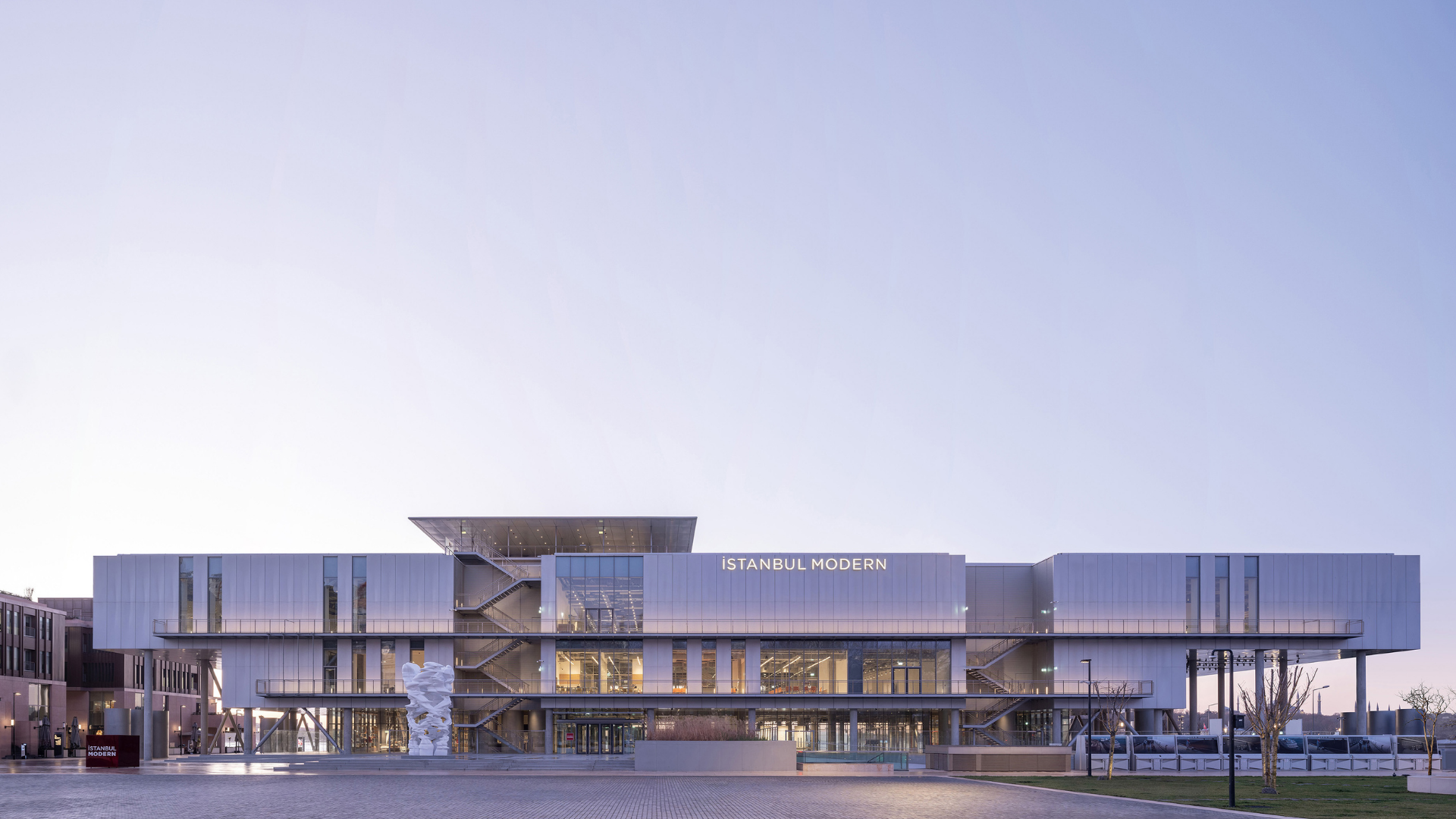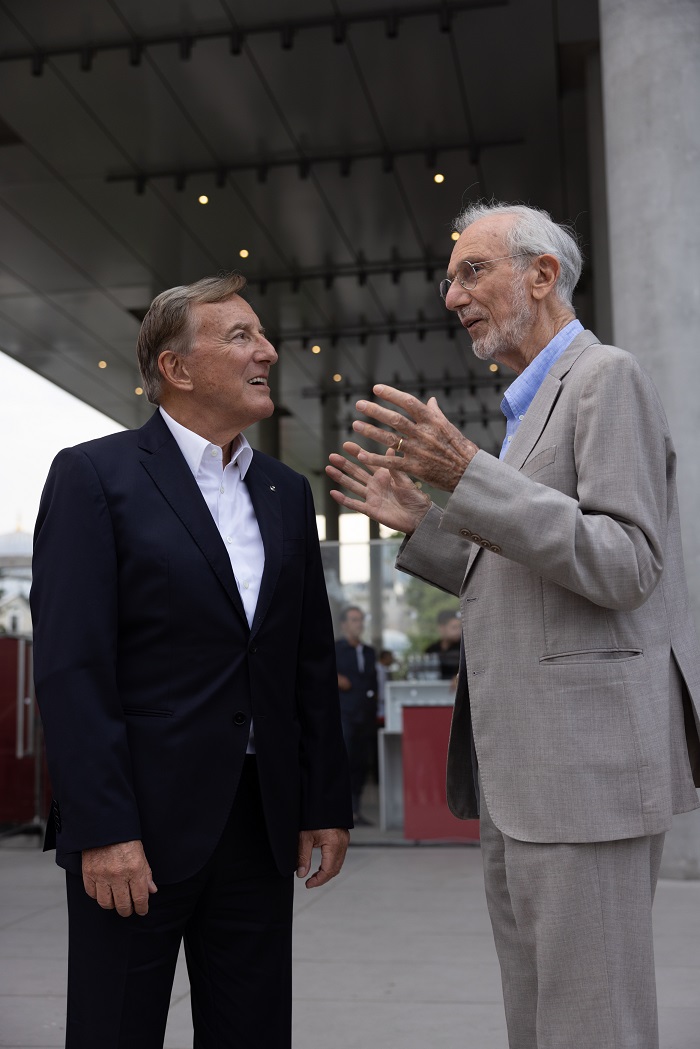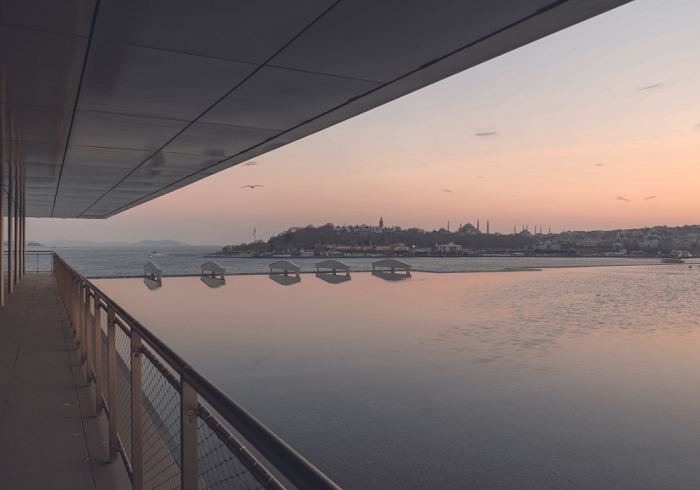Acting on its belief that economic development goes hand in hand with social and cultural development, the Eczacıbaşı Group has sought to strengthen society's connection with the arts for 81 years. The Group is the founding sponsor of Istanbul Modern, Türkiye's first museum of modern and contemporary art and today one the world's leading culture and art institutions.
Revitalized on the 100th anniversary of the Republic of Türkiye as "a gift from Istanbul to the world", Istanbul Modern is now welcoming visitors at its new museum building designed by Renzo Piano, recently listed among the "World’s 50 Greatest Places".
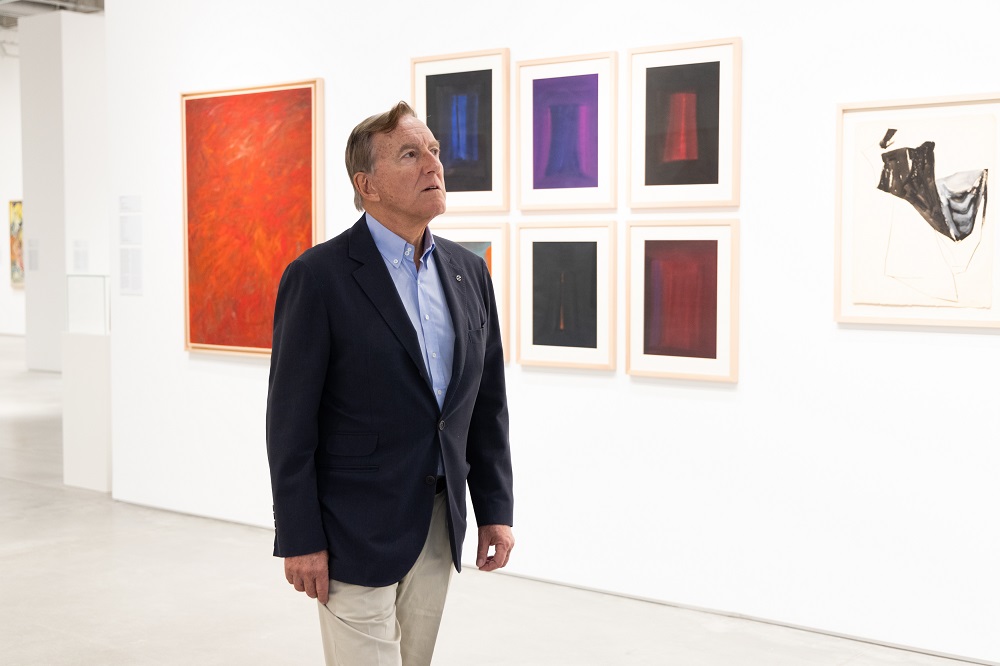
Eczacıbaşı Holding Chairperson Bülent Eczacıbaşı:
"Istanbul Modern's new building is the fulfillment of our dream to enrich Türkiye's cultural heritage."
How would you evaluate Istanbul Modern in the context of the Group's mission to improve social life through investments in culture and the arts?
The Eczacıbaşı Group embraces the view that business has a duty to contribute to the development of society. Our Group’s founder, Dr. Nejat F. Eczacıbaşı, not only had a personal interest in culture and arts, but he also believed in the need for stronger connections between people and the arts in order to promote social development.
Looking back at the founders of the Republic of Türkiye on its 100th anniversary, they clearly had great foresight in focusing on culture and arts even before the wreckage of a devastating war was cleared away. Dr. Nejat F. Eczacıbaşı's enthusiasm and belief in culture and arts stemmed from this momentum. When I look at the progress made by İKSV, founded on the fiftieth year of the Republic, and Istanbul Modern, which has attracted tremendous interest at home and abroad since its opening in 2004, I see that we’ve largely realized Dr. Nejat F. Eczacıbaşı's dreams. I’m delighted that Istanbul Modern is reuniting with the public on the 100th anniversary of the Republic in its new building, an outstanding work of architecture and a tribute to our nation.
We believe that art has great healing power, that it’s a source of inspiration and creativity, and that the more people who share this conviction, the further our country will develop. We work towards this goal through the culture and art institutions we’ve founded.
This perspective was also the basis for establishing Istanbul Modern, Türkiye’s first museum of modern and contemporary art. While revealing Türkiye's artistic wealth on a global scale, the museum will ensure that this legacy is transmitted to future generations.
In our age, museums are no longer just places to exhibit artworks, they’re centers for living where you can immerse yourself in art. With its new building designed by Renzo Piano, one of the most prominent museum architects of our time, Istanbul Modern has taken its place among the world’s best examples of this approach. Istanbul Modern continues to serve the public in its new building by creating opportunities to experience the works of both Turkish and foreign artists.
What are your views on Türkiye's position and future as a "country of culture in an emerging age of culture"? How does İKSV, İKSEV, of which the Group is the founding sponsor and Istanbul Modern, a gift to the 100th anniversary of our Republic with its new building, contribute to Türkiye’s identity as a country of culture?
Türkiye is the inheritor of a great culture that has been seeded by Hittite, Ionian, Roman, Byzantine, Byzantine, Seljuk, and Ottoman civilizations as well as the Republic. Every corner of Anatolia, home to countless cultures, bears the deep traces of civilization. Istanbul, the capital of two great empires that influenced the world, deserves the title of "queen of cities" in every aspect. Our mission is not only to protect this magnificent heritage, but also to represent and develop it with respect. I believe that culture and arts are the most important forces for realizing this mission.
We need to make better use of our country's unique richness in terms of cultural assets and diversity, both to move our society forward and to elevate Türkiye to its rightful place in the world of culture and arts.
In this respect, I believe that Istanbul Modern, whose new building opens on the 100th anniversary of our Republic, will strongly contribute to realizing the words of the Great Leader Mustafa Kemal Atatürk: "We shall elevate our national culture above the level of contemporary civilization."
Renzo Piano has designed a temple of culture in the uniquely beautiful city of Istanbul, on the shores of the Bosphorus and directly opposite the city's historic peninsula. The museum's journey, which began with the Eczacıbaşı art collection, now continues as a global brand. Artworks revealing our country's artistic heritage, creativity, universal values, and contemporary cultural identity reach visitors from all over the world, significantly raising Türkiye’s visibility and station in the field of culture and arts.
For more than 50 years, the Istanbul Foundation for Culture and Arts (İKSV) has successfully promoted Türkiye and Istanbul, motivated and trained artists, supported the production of artwork, introduced Türkiye’s artists to the world, enhanced society’s participation in cultural life, and contributed to the cultural literacy and education of art lovers. The Izmir Foundation for Culture and Arts Education (İKSEV), which is the leading culture and arts organization in Izmir, hosts global talent every year at the International Izmir Festival and organizes competitions and other events that foster the public’s appreciation of contemporary arts.
Ensuring that future generations appreciate and enjoy art has been one of Istanbul Modern's main goals since its foundation. As the museum approaches its 20th anniversary, what can you say about the impact this mission has had and will continue to have on younger generations?
The Eczacıbaşı Group has always taken a long-term approach to its mission of improving social life. Young people are the future of society and our most important asset, capable of realizing Türkiye’s potential. Our founder Dr. Nejat F. Eczacıbaşı believed that youth and old age have nothing to do with one's physical age. He used to say, "A person who lives looking backward is old, a person who looks forward is young, regardless of their age." I, too, have great confidence in youth.
In line with our motto "Young people matter at Eczacıbaşı," we not only design training, career, and internship programs for young Eczacıbaşı employees, we also reach out to the youth of our country with programs that increase their access to sports, science, education and culture and arts.
The Eczacıbaşı Youth Ticket program, for example, offers tickets for university students to all İKSV festivals at the highly discounted rate TL 20 (less than half a euro). We’re also the sponsor of Istanbul Modern’s Young Tuesday program, which offers 18-25-year-olds free access to Istanbul Modern exhibitions on Tuesdays.
You’ve pursued photography for many years. Your photographs of the construction process of Istanbul Modern's new building were curated for the exhibition "Reflections of a Transformation: Towards the New Istanbul Modern" and a publication of the same name. How did this idea come about and what would you like to share about bearing witness to the construction process?
Istanbul Modern's new building is the fulfillment of the dream of "combining technology and human labor with a superior aesthetic to enrich the country's cultural heritage." "Reflections of Transformation: Towards the New Istanbul Modern" is a manifestation of the excitement I experienced during the construction of Istanbul Modern's new building. The idea emerged from my desire to share this excitement. Through the photographs I took between February 2021 and March 2022, I tried to tell the story of the building's construction from my own perspective. I tried to capture "moments" of the structure’s rapid transformation, the functioning of the construction site, the work of laborers, the rhythmic movement of construction.
I also aimed to take the viewer on a journey through the building's unseen and unknown states, which inevitably disappeared when its construction was complete. Through portraits of people at work, I wanted to highlight human labor and the workers who left their traces all around the building.
Oya Eczacıbaşı, Chairperson of the Board of Istanbul Modern:
"I believe that with our new museum building, we will establish stronger ties with art lovers and young audiences."
As the first modern and contemporary art museum in Türkiye, how did Istanbul Modern's journey begin? What role has the museum played in shaping Türkiye 's culture and art life?
The opening of Istanbul Modern in 2004 was the outcome of many years of intense and devoted effort. The idea of establishing a modern art museum, which was sorely lacking in Istanbul, emerged after the 1st Istanbul Biennial in 1987.
From then on, our priority was to establish a museum that would contribute to the development of culture and arts in Istanbul.
Efforts to find a suitable location for the museum continued for more than 15 years. Finally, we decided that Antrepo No. 4, which served as the exhibition space for the 8th International Istanbul Biennial in 2003, would be the most suitable building for this purpose.
Istanbul Modern opened its doors to the public on December 11, 2004.
We’ve achieved many more milestones since then. We organized countless events in every art discipline
Very quickly, Istanbul Modern became one of the city's must-see cultural and artistic centers for international visitors and assumed an active role in conveying Türkiye's artistic production to national and international audiences.
The new building was designed by Renzo Piano, recognized as the world's most accomplished museum architect. How did you decide on Renzo Piano?
We had been thinking for some time that the Antrepo building, which enabled the establishment of Istanbul Modern and the realization of our activities, was no longer able to meet all our requirements. We needed a world-class building to raise our bar to the level of the world's leading modern art museums. The redevelopment of the port area, which includes Istanbul Modern, created an opportunity for fulfilling this dream.
From day one, Renzo Piano was our first choice due to his expertise and unique experience in museum architecture, and the fact that every museum and art institution bearing his signature has become a city landmark. At our first meeting with Renzo Piano in 2014, he embraced our dream of creating a museum building that would attract the attention of international art circles and reflect the true worth of our wonderful and incomparable city.
While the new building designed by the Renzo Piano Building Workshop was being constructed, we continued the museum’s activities at a temporary space in Beyoğlu.
After a four-year interval, we’re delighted to be back at our original location in a new building that I believe will become one of the symbols of Istanbul. We are indescribably proud and happy to present this new building to our city on the 100th anniversary of our Republic.
What are your dreams and expectations for the new era of Istanbul Modern?
Istanbul Modern is in Tophane, an area that has been Istanbul's point of contact with the world throughout history, bringing together merchants, sailors, cultures, and languages from many different geographies. We want to advance our goal of being a museum that connects Turkish art with the world while preserving the historical heritage of this area, one of Istanbul's gateways to the world.
I believe that our new museum building will not only offer us brand new opportunities on this path but will also add great value to both our city and our world of culture and arts.
With the start of our journey in the new museum building, our responsibilities have also increased. One of our main priorities in the new period will be to enrich our collection in line with our goals of transmitting Türkiye's modern and contemporary art history to future generations and presenting prime examples of contemporary art to our audiences. We will also continue to develop our educational programs and events. Thanks to the opportunities and momentum provided by our new building, I believe we will establish stronger ties with art lovers and young audiences.
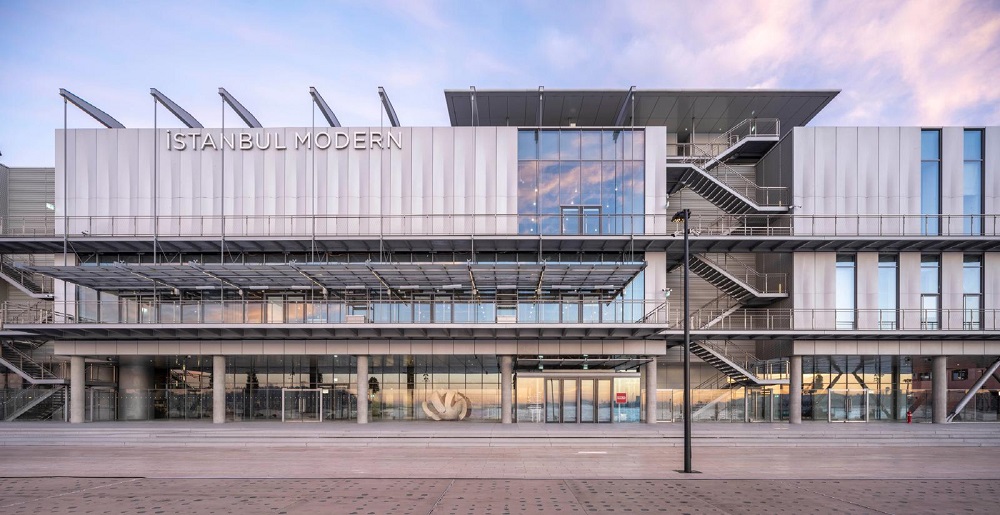
The eyes of the world press are on Istanbul Modern
The opening of Istanbul Modern's new museum building was widely covered in the world press. In The New York Times, David Belcher wrote an article about Istanbul Modern's new building designed by Renzo Piano, noting that the opening exhibitions were a tribute to modern art. Francesco Merlo, who interviewed Piano about the design process of Istanbul Modern in La Repubblica, compared the building to a "flying ship" and described it as a dance of light and water. Stefan Trinks of the German publication Frankfurter Allgemeine Zeitung described Istanbul Modern as "Türkiye's Centre Pompidou".
The article describes the new museum building as simple and elegant in its architecture, while the collection exhibition offers an almost complete overview of the many phases of art in Türkiye since 1945.
The US-based TIME magazine included Istanbul in its list of the " World's 50 Greatest Places" with the title "A classic reborn".
Describing Istanbul as the most magical city in Türkiye, the article also featured Istanbul Modern's new museum building in Karaköy, designed by the famous architect Renzo Piano.
Click on the link below for the article on TIME magazine's website.
https://time.com/collection/worlds-greatest-places-2022/6194519/istanbul/
Istanbul Modern was the first guest of the BBC's documentary "Inside Museums".
The first episode of the BBC News channel's documentary series, "Inside Museums", focusing on the world's most inspiring museums, was devoted to Istanbul Modern. In the 24-minute documentary prepared by art critic Alastair Sooke, Istanbul Modern's new museum building is explored through the narration of architect Renzo Piano, while interviews with artists featured in the collection exhibition take us on a journey through Turkish art.
The documentary begins with Renzo Piano, the architect of Istanbul Modern's new museum building, talking about his design and the inspiration he found in the reflections of light and the sparkling waters of the Bosphorus. This interview is followed by conversations with several artists featured in the collection exhibition –Gülsün Karamustafa, Refik Anadol and İnci Eviner – and a detailed description of Fahrelnissa Zeid's "My Hell", one of the masterpieces of the Istanbul Modern collection.
In the documentary, Alastair Sooke tries to discover what makes the art emerging from Istanbul, which he describes as a unique meeting point of cultures, so special. Sooke reveals this discovery through the eyes of Türkiye's leading artists.
Click here to watch the program.

